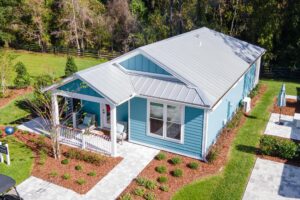What does it mean to go green? With the world’s health in focus, “going green” is no longer just a trendy phrase, but an important topic of discussion. A call to action; a commitment for individuals to adopt eco-friendly practices in their daily lives. Behind this action is the intent to reduce environmental harm.
Going green means making choices to help the planet by reducing our impact on the environment. A huge part of those choices involve saving energy. Fortunately, there are active and passive ways to enhance energy-efficiency in your home. In this blog, we’ll explore what it truly means to go green, why it matters, and how your home’s construction can impact the environment.


Go Green – What Does it Mean?
Go Green – What Does it Mean?
“Going green” is commitment to a lifestyle that prioritizes sustainability, conservation, and environmental responsibility. It involves making choices that consider the long-term health of the planet and its ecosystems. This idea includes many parts of life, like the things we use, the energy we use, and the trash we make.
An essential practice in living greener is to save energy. By adopting energy-efficient practices, you contribute to sustainability, conserving natural resources, and combating climate change. Saving energy by going green benefits the planet, saves money, and creates a stronger and more sustainable future.


Why Saving Energy Matters
We often receive instructions to ensure that we turn off the lights and water as frequently as possible to save energy. It’s true that this practice is better for the environment.
Imagine your home uses electricity for things like lights, heating, and appliances. This electricity often comes from power plants that burn fossil fuels like coal, oil, or natural gas. When burning these fuels, they release gasses into the air, including carbon dioxide (CO2), a greenhouse gas.
Reducing energy consumption at home means using less electricity. When you use less electricity, power plants need to produce less of it. This is important because producing electricity from fossil fuels releases greenhouse gasses into the atmosphere.


Go Green by Saving Energy at Home
To actively save energy at home, unplug electronics when not in use, turn off unnecessary lights and devices, and save water. But equally as important are the building blocks of your home: walls, doors, windows, and roof. With the right energy-efficient components, your home can save energy with little effort. In our central Florida community, our builder ensures these features are energy-efficient on all our homes.
Energy Efficient Walls
2×6 walls are better for the environment than 2×4 walls because they are thicker and provide better insulation. The additional space in 2×6 walls enables higher insulation levels, enhancing energy efficiency and reducing heating and cooling demands. For example, we utilize 2×6 wall frames and R-19 batt insulation in our Lakeshore cottages. Increased insulation leads to lower energy consumption and associated carbon emissions, contributing to environmental sustainability. This potential for improved insulation in 2×6 walls aligns with green building practices, emphasizing energy conservation and overall environmental impact.


Energy Efficient Doors
Fiberglass doors are generally considered more environmentally friendly than solid wood doors. Fiberglass is man-made from glass fibers and resin, better for the environment than cutting down trees for wood. Solid wood doors often involve deforestation, energy-intensive milling, and transportation.
Fiberglass doors are durable, and are energy-efficient in their ability to last longer than solid wood doors. Recycling this kind of door can also contribute to resource conservation. Fiberglass doors are generally considered the more sustainable and eco-friendly choice.
Energy Efficient Windows
Windows use 25% – 30% of your home’s heating and cooling energy, says the U.S. Department of Energy. This is why it’s more important now than ever to invest in double or triple-paned windows. These types of windows have multiple panes of glass with a sealed space between that reduces heat transfer.
Our cottage homes at Lakeshore boast double-paned windows that help control indoor temperatures and reduce the need for excessive heating or cooling. By reducing the workload on your HVAC system, you save more energy.
Energy Efficient Roofing
Metal roofs offer several environmental benefits over shingled roofs, making them a more sustainable choice. One significant advantage is the longevity and durability of metal roofs. Metal roofs have a lifespan of about 50 – 70 years compared to the 15 – 30 years of traditional asphalt shingle roofs. Less replacements are required as a result, reducing environmental impact of manufacturing, transporting, and disposing.
The reflective property of metal also reduces heat absorption, thus keeping the building cooler. Less cooling equals lower energy consumption. By reducing the demand for air conditioning, metal roofs can lead to lower greenhouse gas emissions.
For this reason, all our buildings at Lakeshore boast metal roofs, from the community clubhouse to each of our cottage homes.


Devices for Saving Energy
Lakeshore’s homes are designed from the beginning to reduce energy usage. However, if you’re looking for easy and strategic upgrades to reduce your energy consumption, investing in energy-efficient devices is an excellent extra step you should take. Here are some effective ways to save energy around your home without the need for major renovations:
1. Programmable Thermostat – Install a programmable thermostat to optimize heating and cooling. Set efficient temperatures during the night and when you’re away to reduce energy usage. The Mississippi State University explained that with a properly optimized temparature schedule, you can save up to 10% in yearly heating and cooling costs.
2. LED Lightbulbs – Replace old incandescent bulbs with energy-efficient LED bulbs. LED lighting saves about $225 in energy costs each year. If you’re not using LED bulbs, it’s time to swap! Embracing natural light during the day by opening curtains and blinds can also eliminate the need to have as many lights on during the day.
3. Smart Plugs – Investing in smart plugs that automatically turn devices on and off can also save energy and money. You may not realize it, but devices and appliances that are turned off but plugged in still consume energy. To limit this waste, connecting energy-consuming electronics to smart plugs offers more efficient control.
By incorporating these practices into your daily routine, you can make your home more energy-efficient without undergoing major renovations. These simple steps not only contribute to environmental sustainability but also help reduce your energy bills over time. Making conscious choices in your energy usage is a small yet impactful way to create a greener and more cost-effective living space.


Going green means committing to sustainable living. When you prioritize energy efficiency in your home, you’re reducing your daily environmental impact in a big way. Saving energy at home, from unplugging electronics to investing in energy-efficient features like walls, doors, windows, and roofs, plays a pivotal role. In our Lakeshore community, we emphasize these practices while utilizing energy-efficient materials to build our homes. Go green and find your perfect energy-efficient cottage home today!





